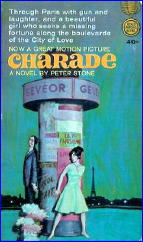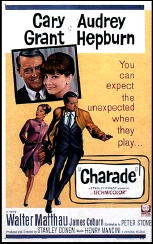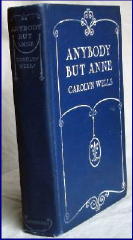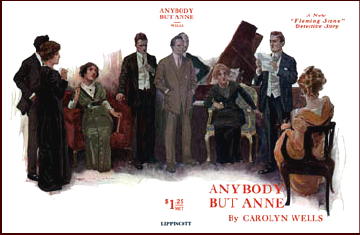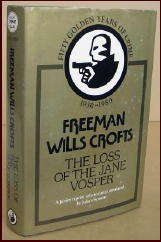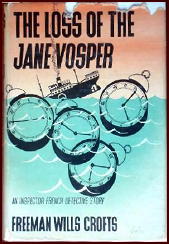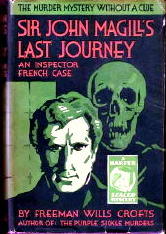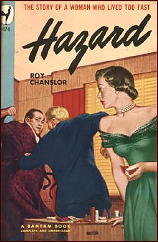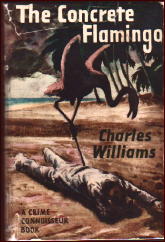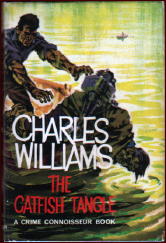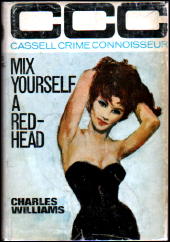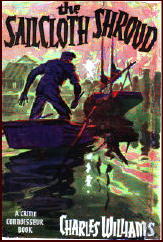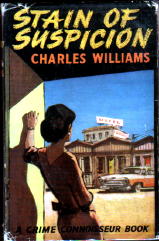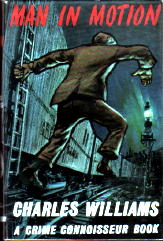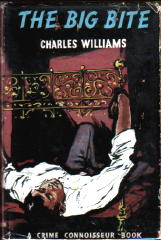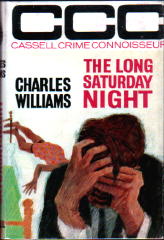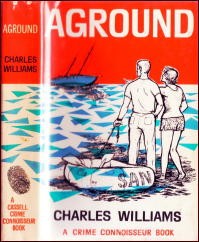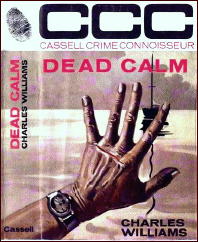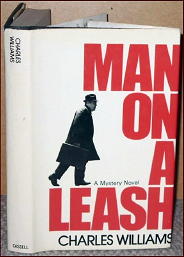NICHOLAS FLOWER on Charles Williams:
My father, Desmond Flower, was the Literary Director of Cassell at the time I joined the firm in the 1950s. He visited New York every year to buy books for UK publication from NY publishers and agents. On one of his visits he was given a copy of Scorpion Reef for consideration.
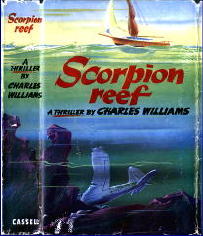
This, the Macmillan (NY) edition, must have been the first hardcover edition of a thriller by CW. My father liked it, bought the rights and we published it in 1956.
It was critically well received and this led to the idea of reissuing his Gold Medal paperbacks as hardcovers in the Cassell crime list.
As is clear from the order of their publication, there was no correspondence between the order of original Dell or Gold Medal publication and the order in which we republished them. Some of them were republished under their paperback titles, such as The Big Bite, but it was felt that some of the titles, particularly the “Girl” titles, were not right for the hardcover market.
It was at this point, before I took over editorial control of the Crime list in 1960, that I got involved with CW, because the pleasant task of thinking up new titles was left to me. Each time we were resetting a book for which we felt a new title was needed, I would write to CW with a suggestion and he accepted every one.
Those I remember putting to him include:
Operator [Cassell, 1958; previously Girl Out Back, Dell 1958]
The Concrete Flamingo [Cassell, 1960; previously All the Way, Dell 1958].
The Catfish Tangle [Cassell, 1963; previously River Girl, Gold Medal 1951].
Mix Yourself a Redhead [Cassell, 1965; previously A Touch of Death, Gold Medal 1954]
The Hot Spot [Cassell, 1965; previously Hell Hath No Fury, Gold Medal 1953].
Because the decision to reissue earlier titles in hardcover, and to retitle some of them, had been taken by Cassell, the US hardcover editions of Gold Medal reissues followed within the same year. New titles, written by CW after 1958, such as Aground and Dead Calm, went straight into hardcover, the US edition preceding the Cassell edition.
The reissuing of the Gold Medal books in hardcover, many with new titles, played a crucial role in the continuation of CW’s success. It led to the creation of a new audience, not least through library sales. It brought him to the attention of critics in the mainstream and publishing trade press where, on both sides of the Atlantic, he was consistently well reviewed.

This rebirth of his books led in turn to their reissue, under the new titles, in two further paperback phases: first, following on directly from the hardcover editions, by Pan in the UK, and Pocket Books and Harper and Row in the US; then later, through another phase of reissues, in the 80s and 90s, by publishers such as Penguin and No Exit Press.
The photo attached is one I took of Charles Williams on the top floor of the Cassell building in Red Lion Square, London, in the early 60s.
On the literary side, I have always divided his thrillers, not into sea vs land, but into water vs land. In all the books which contain boats, fishing, water and swamp, there is a deeply nostalgic and pervasive atmosphere of mystery – smooth water providing both a feeling of calm and of hidden menace.
There is no better example of a water novel than what I retitled The Catfish Tangle, the title referring to the catfish which Shevlin catches for the restaurant at the head of the lake.
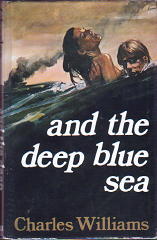
In the 60s, Cassell and Collins were the pre-eminent UK publishers of blockbuster novels. Our authors included Alec Waugh, Nicholas Monsarrat, Irving Stone and Irving Wallace. The last time CW visited our office, I put to him the idea that he could write a wonderful full-length novel using a liner as the setting.
And the Deep Blue Sea ((Signet, pb, 1971; Cassell, 1972) is, in my opinion, not really a sea novel; the liner in the book is merely a platform for psychological interplay and misdeeds. I do not think it is successful as a thriller, but it clearly shows what he could have achieved through his powers of characterisation had he been prepared to work on a bigger canvas.
Might it have revitalised his career? Sadly we shall never know. He said no; he was happy doing what he knew best and felt he was too stuck in his ways.
___
NOTE: For an essay by Bill Crider on Charles Williams, along with a complete bibliography, follow this link to the primary Mystery*File website.
___
[UPDATE] 02-01-09. After making a couple of minor edits in the piece above, Nicholas and I have been discussing some of the other books by CW that Cassell published. One of them was The Sailcloth Shroud, which was published first in the US in hardcover (Viking, 1960; Cassell, 1960).
No change in title was made for this one:
There are two others for which the titles were changed, but for these Nicholas says: “I did not think up the the titles [for these two books]. I have a feeling (no more than that) that CW may have retitled them himself.”
Stain of Suspicion [Cassell, 1959; previously Talk of the Town, Dell First Edition, 1958]
Man in Motion [Cassell, 1959; previously Man on the Run, Gold Medal, 1958]
Two additional books were published first as paperback originals in the US, then by Cassell in the UK. There were no changes in title for either of these:
The Big Bite [Cassell, 1957; Dell, 1956]
The Long Saturday Night [Cassell, 1964; Gold Medal, 1962]
[LATER.] 03-17-09. In his most recent email, Nicholas adds the following:
“I left Cassell in 1970 following the take-over of the company by Crowell Collier Macmillan of New York. By then all but one of CW’s novels, Man on a Leash, had been published.
“In 1965 the name of the crime list was changed to CASSELL CRIME and the decision was taken to reduce production costs by introducing a standard in-house series cover. The three band covers, which I designed, each featured a studio photograph incorporating elements of the story. The Hot Spot was the only CW thriller to appear with a CC series cover.”
[UPDATE #2] 09-11-10. Twelve covers are reproduced above, but Cassell actually published fifteen of Charles Williams’s thrillers, not including his comic crime stories, such as The Wrong Venus and The Diamond Bikini.
Thanks to the assistance of some online booksellers who graciously supplied us with the three previously missing, we can now display the covers of all fifteen:
Aground. [Cassell, 1961; Viking, US, hardcover, 1960; Crest s471, US, pb, 1961; Pan, UK, pb, 1969]
Dead Calm. [Cassell, 1964; Viking, US, hardcover, 1963; Avon G1255, US, pb, 1965; Pan, UK, pb, 1966]
Man on a Leash. [Cassell, 1974; G. P. Putnam’s Sons, hardcover, 1973; no paperback editions]
For these last three covers, thanks to Nigel Williams Rare Books, London, for the cover image to Aground; to Instant Rare Books of Auckland, New Zealand, for Dead Calm; and to The Antique Map & Bookshop, Puddletown, Dorset, for Man on a Leash.
Finally, a special note of thanks to Mark Terry of www.facsimiledustjackets.com, who earlier supplied the cover of Scorpion Reef, and to Bill Pronzini, who sent me all the others.

